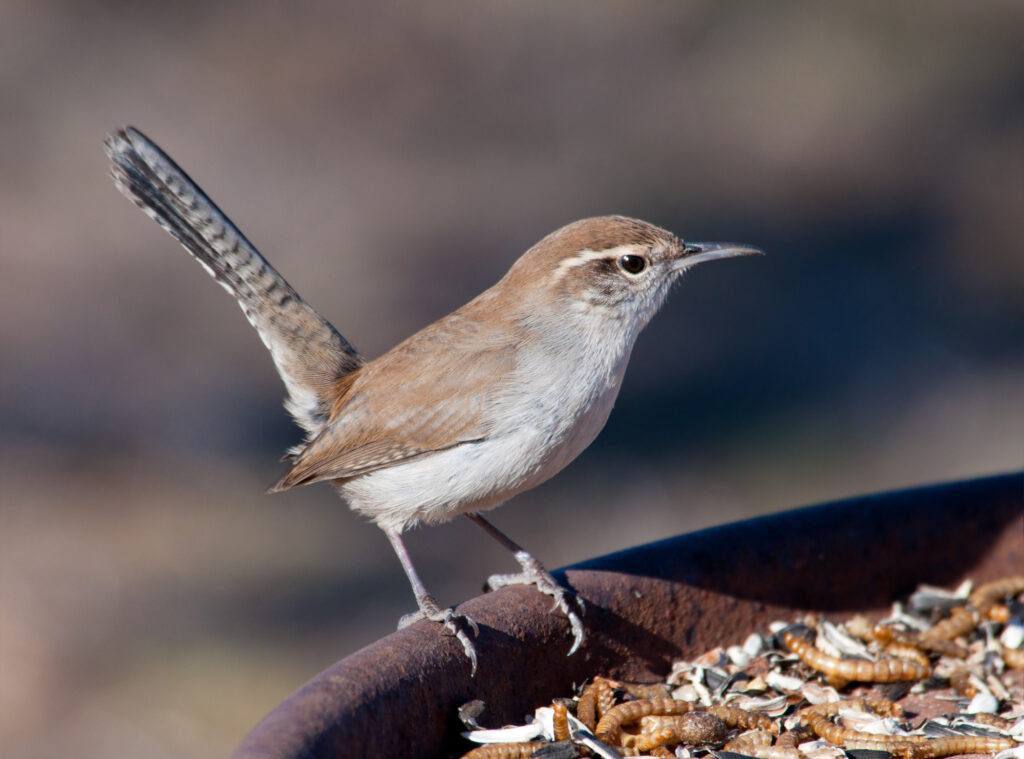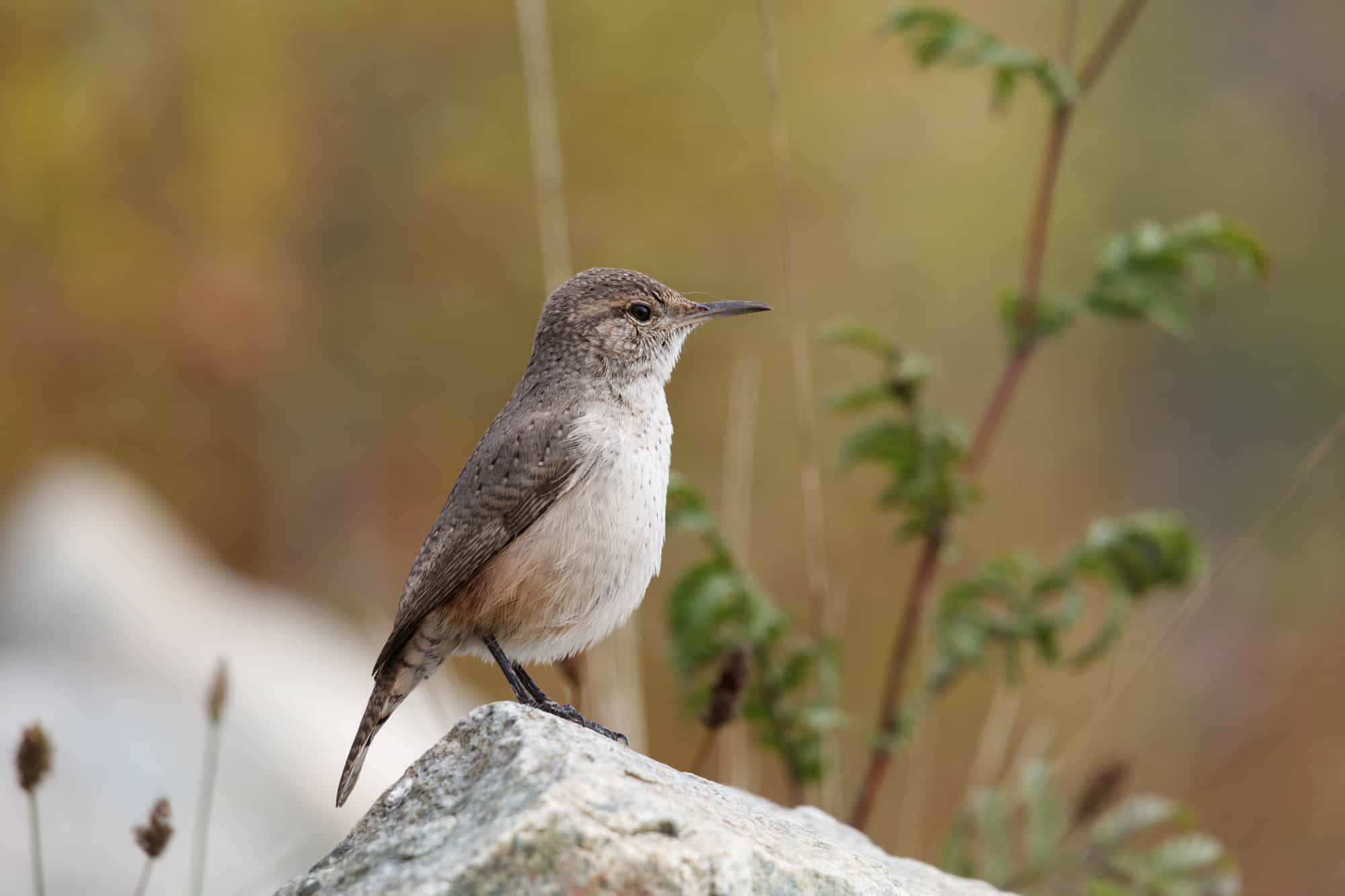With its southerly maritime position, Georgia offers a warm climate for birds and birdwatchers to enjoy year-round.
Of the 11 species of wren that are native to the USA, 7 of them can be found in Georgia. While some of them simply take advantage of the state’s mild winters and migrate north for nesting, others remain here for the whole year.
Wrens are one of the most endearing backyard birds, and certain species will use birdhouses to shelter in during winter as well as to nest in during the spring and summer.
Only a few wrens visit backyard feeders, but most species will frequent gardens more regularly when given some overgrown corners to forage for the insects that provide much of their sustenance.
But exactly which wrens can be spotted in Georgia? I’ll be impressed if you can guess all 7 species before scrolling down. See if you can!
Wrens in Georgia, Starting With the Most Frequently Seen
Carolina Wren

- Scientific Name: Thryothorus ludovicianus
- Length: 4.7-5.5 in (12-14 cm)
- Weight: 0.6-0.8 oz (18-22 g)
- Wingspan: 9 in (23 cm)
According to bird watchers reports on ebird.org, Carolina wrens are spotted about ten times more often than any other wren in Georgia. These undisputed kings of the Eastern States are also larger than any other wren on our list.
Carolina wrens are pretty birds with long white eyebrows, white chins, and a light pinkish to orange chest. The male’s simple song is a repetition of a tuneful chant, while females will occasionally chatter as they listen.
You can find Carolina wrens in overgrown shrubby surroundings in a wide variety of habitats. They seem equally at home in woodland undergrowth as they do in weedy corners of suburban gardens.
You can improve your chances of attracting Carolina wrens to your backyard by offering them a suitable nest box. They’ll occasionally visit platform feeders and tube feeders during the winter months, too.
House Wren

- Scientific Name: Troglodytes aedon
- Length: 4.3-5.1 in (11-13 cm)
- Weight: 0.3-0.4 oz (10-12 g)
- Wingspan: 5.9 in (15 cm)
Did you know that the humble house wren is the most widespread native bird in all the Americas? You can find these endearing little brown jobs from Northern Canada to the tip of Patagonia.
In Georgia, house wrens are not especially common birds, but it is one of the few states where they can be seen right around the year. While the south of the state is merely an overwintering ground for them, the north of the state represents their southernmost breeding grounds.
Watching a pair of house wrens raise a family is a real treat, and they’ll readily adopt any kind of cavity to make their home in. From old mailboxes to coat pockets, house wrens will also eagerly take up residence in a suitable nestbox.
While they don’t visit bird feeders, you can improve the food supply of the adorable house wren by leaving overgrown corners of your garden for them to forage for insects and spiders.
Winter Wren

- Scientific Name: Troglodytes hiemalis
- Length: 3.1-4.7 in (8-12 cm)
- Weight: 0.3-0.4 oz (8-12 g)
- Wingspan: 4.7-6.3 in (12-16 cm)
The hardy winter wren really is only a winter bird in Georgia and is spotted by just over 3% of bird watchers during the colder months. In the summer, these small but mighty birds fly north for breeding, with a range that extends all the way to The Hudson Bay.
Winter wrens share the joint honor of being the smallest wren in North America with their western relative the Pacific wren. The two species are so similar that, until recently, they were thought to be identical!
Your best chance of spotting winter wrens is among the undergrowth in damp, shady places, especially near streams and waterways. Look out for these cheerful, energetic birds hopping around on fallen branches and tree stumps looking for insects and other invertebrates to eat.
Winter wrens will also sometimes visit backyards, and residents of Georgia can improve their chances of seeing them by leaving up their nest boxes over the winter. The otherwise solitary winter wren is famous for congregating in cavities to stay warm during cold nights!
Marsh Wren

- Scientific Name: Cistothorus palustris
- Length: 3.9-5.5 in (10-14 cm)
- Weight: 0.3-0.5 oz (9-14 g)
- Wingspan: 5.9 in (15 cm)
Whereas our first few wrens can be seen in backyards, you’ll probably need to go on a dedicated outing to see the marsh wren. These birds are so faithful to marshland habitats that they’re rarely seen anywhere where there’s no standing water.
A good pair of binoculars and an attentive ear are essential companions for observing marsh wrens. These secretive birds are often difficult to see among the wetland vegetation, except when belting out their assertive songs and calls.
The marsh wren’s territorial antics are especially pronounced during breeding time, and an interesting subspecies ‘Worthington’s marsh wren’ can be found nesting along the eastern seaboard of the state during the spring and summer.
While most marsh wrens are brown, white, and black in color, and only breed in the Northern States, Worthington’s marsh wren is almost completely gray and is found year-round from South Carolina to Northern Florida.
Sedge Wren

- Scientific Name: Cistothorus stellaris
- Length: 3.9-4.7 in (10-12 cm)
- Weight: 0.3oz (7-10 g)
- Wingspan: 4.7-5.5 in (12-14 cm)
A close relative of the marsh wren is the sedge wren – notice how the two species share the same genus name. Sedge wrens are slightly smaller than marsh wrens, though, and are also much rarer.
In addition to their small population, the sedge wren’s secretive nature makes them even harder to spot! Instead of flying, they’ll often creep through sedge grass vegetation and are so well camouflaged they can be near impossible to observe except when singing.
Sedge wrens are purely winter visitors in Georgia and migrate to the Northern USA and Central Canada for breeding. They’re usually found in slightly drier habitats than marsh wrens, including damp meadows.
Although official reports state that sedge wren numbers are stable, some ornithologists are concerned that their numbers are declining due to habitat loss.
Bewick’s Wren

- Scientific Name: Thryomanes bewickii
- Length: 5.1 in (13 cm)
- Weight: 0.3-0.4 oz (8-12 g)
- Wingspan: 7 in (17.8cm)
While Bewick’s wren remains a common bird in the Southwestern United States, their eastern populations have plummeted dramatically over the last several decades.
It’s not known exactly why Bewick’s wrens are rarer than they once were, but it’s thought that competition from house wrens has contributed to their demise.
While Bewick’s wren would have once been seen more regularly in Georgia, they’re now only spotted by less than one in a thousand bird watchers here.
This is a shame because Bewick’s wrens are pretty little birds with white eyebrows, a light gray belly, and a long tail that is often flicked and fanned to reveal its white corners.
Rock Wren

- Scientific Name: Salpinctes obsoletus
- Length: 4.9-5.9 in (12.5-15 cm)
- Weight: 0.5-0.6 oz (15-18 g)
- Wingspan: 8.7-9.4 in (22-24 cm)
More of a bird of the Western States, the rock wren is very rarely seen in Georgia. A sighting of this species this far east is a newsworthy event in the birdwatching world since they only show up every few years.
Rock wrens are larger than many wren species and are fairly pale in color. Their long bill and long legs give them an elegant appearance.
In their Western home, rock wrens are typically found among rock piles, and will often use a rock to perch upon as they sing their buzzy song.
If you do manage to spot a rock wren in Georgia, try to get a photo and report it to a local birdwatching authority such as The Georgia Ornithological Society (GOS).
Conclusion
It’s possible to see 7 wrens in Georgia, although you’d have to be a very dedicated birdwatcher to spot them all! In the meantime, you can enjoy attracting the more common species to your backyard by following the suggestions given above.
Asides from wrens, there are more than 400 species of birds in The Peach State. Indigo buntings, Vermilion Flycatchers, and Belted Kingfishers are just a few of the incredible species that we cover in our guide to 25 Beautiful Birds of Georgia.

